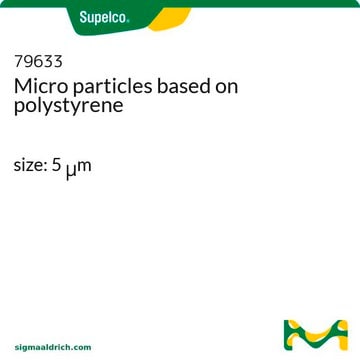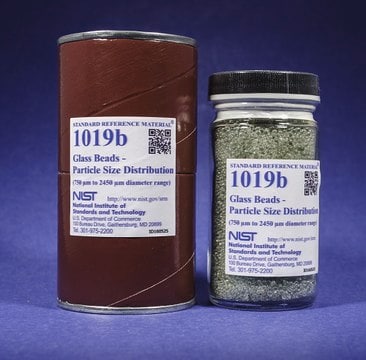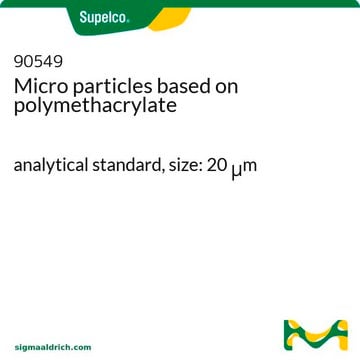44054
Micro particles based on silicon dioxide
size: 5 μm
Synonim(y):
Silica dioxide microsphere (5 μm), Micro silicon (5 μm), Beads based on silicon dioxide, microsize, Silicon dioxide beads
About This Item
Polecane produkty
klasa czystości
analytical standard
Postać
aqueous suspension
stężenie
5% (solids)
wielkość cząstki
5 μm std dev ≤0.35 μm
Zastosowanie
glass & ceramic
industrial qc
pharmaceutical
format
neat
temp. przechowywania
2-8°C
ciąg SMILES
O=[Si]=O
InChI
1S/O2Si/c1-3-2
Klucz InChI
VYPSYNLAJGMNEJ-UHFFFAOYSA-N
Szukasz podobnych produktów? Odwiedź Przewodnik dotyczący porównywania produktów
Powiązane kategorie
Opis ogólny
The particle diameter of 5 μm is measured using Coulter Multisizer.
Zastosowanie
- to study transport properties of microscopic particles via heterogeneous media
- as a test standard to validate denoising method used in optical diffraction tomography
- in accelerated annealing experiments involving colloidal silica monolayers
- to evaluate the measurement accuracy of color-coded LED microscopy (cLEDscope) technique
- as a calibration standard in optical trapping system to measure surface mechanical properties
Cechy i korzyści
- suitable for routine instrument calibration monitoring, testing and corrections
- particle size traceable to Community Bureau of Reference (BCR) standards
- available in 5 mL pack size as a neat sample
Kod klasy składowania
10 - Combustible liquids
Klasa zagrożenia wodnego (WGK)
WGK 2
Temperatura zapłonu (°F)
Not applicable
Temperatura zapłonu (°C)
Not applicable
Środki ochrony indywidualnej
Eyeshields, Gloves
Certyfikaty analizy (CoA)
Poszukaj Certyfikaty analizy (CoA), wpisując numer partii/serii produktów. Numery serii i partii można znaleźć na etykiecie produktu po słowach „seria” lub „partia”.
Masz już ten produkt?
Dokumenty związane z niedawno zakupionymi produktami zostały zamieszczone w Bibliotece dokumentów.
Klienci oglądali również te produkty
Nasz zespół naukowców ma doświadczenie we wszystkich obszarach badań, w tym w naukach przyrodniczych, materiałoznawstwie, syntezie chemicznej, chromatografii, analityce i wielu innych dziedzinach.
Skontaktuj się z zespołem ds. pomocy technicznej






